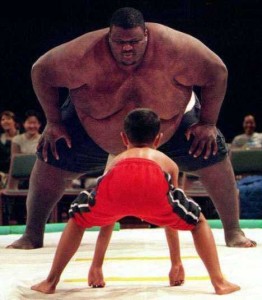A small computer service company wants to sell Microsoft software licenses to its customers. They send an employee to become certified in licensing. (Microsoft offers some 600 variants.). As soon as they purchase a license, however, Microsoft begins soliciting that customer for other software, add-ons and renewals.
Amazon is building ten distribution centers of 1,000,000 square feet or more. Their professed strategy is to deliver most products, from flowers to televisions, anywhere in the continental United States within one day of the order being placed on the Internet.
A small creative agency has for years made its living doing logos and websites for local businesses. Now logotournament.com can provide 20 or more designers and hundreds of concepts for a few hundred dollars. GoDaddy.com will host websites starting at $2.99 a month, or a full year for what it costs the local shop to pay a single developer for an hour.
The Gini Coefficient measures the disparity between rich and poor in a nation. A coefficient of zero means that everyone has exactly the same. A coefficient of 1 means that a single person owns everything. In the US, the coefficient has increased by about 20% over the last 30 years, meaning that more wealth is concentrated in the hands of fewer people.
Some politicians point to that shift as de facto evidence of the evil greedy rich amalgamating wealth at the expense of the common folks. In reality, the addition of a few score billionaires has relatively little impact on the largest economy in the world.
 Studies show that the disparity is increasing in all of the developed countries, and one of the biggest culprits is technology. Desktop computers have eliminated the typing pool. All-in-one printer/copiers have crippled the small print shop industry. Email and online document storage are chipping away at the employee populations of UPS, FedEx and the Postal Service. Millions of jobs that paid middle-class wages without requiring extensive education or skills have been automated and eliminated.
Studies show that the disparity is increasing in all of the developed countries, and one of the biggest culprits is technology. Desktop computers have eliminated the typing pool. All-in-one printer/copiers have crippled the small print shop industry. Email and online document storage are chipping away at the employee populations of UPS, FedEx and the Postal Service. Millions of jobs that paid middle-class wages without requiring extensive education or skills have been automated and eliminated.
The same thing is happening in the battle between small and big business. In the quest for increased revenue, big business keeps moving to fill the entire space between the product source and the end user. Wal-Mart started by corralling the consumer, then worked its way back up the supply chain to eliminate distributors, consolidators and finally, the manufacturers themselves.
Amazon is doing it by replicating the convenience of last-minute local purchase. Microsoft is using technology to approach millions of end users individually. Internet disrupters like LogoTournament are commoditizing personal services by creating global access to low-cost providers.
In the battle for customer relationships, small businesses are also utilizing technology. Inside sales departments can touch accounts more frequently by telephone and email without the expense of paying someone to drive from customer to customer. Electronic newsletters and on-line ordering reduce the cost of transactions. Dependence on technology, however, puts a small business in the same sandbox as the giants. What is the difference between ordering hardware on-line from the local fastener jobber, and doing the same thing on-line with Amazon, if both can deliver the next day?
Eight-five percent of face to face human communication is non-verbal. Relationships are built by human beings looking at each other. For decades advisors have told small business to differentiate with service; that closeness to the customer is the ultimate trump card over the faceless technology of giant competitors.
Duplicating the technology of the giants isn’t getting you closer to your customer. Look over the list of your best customers. How many have you seen face-to-face in the last three months? In the last six months? If it is longer than that, you may be holding your own in the technology battle, but losing the war.
photo credit www.amazingbusiness360.com

2 Responses to Does Technology Help or Threaten Small Businesses?